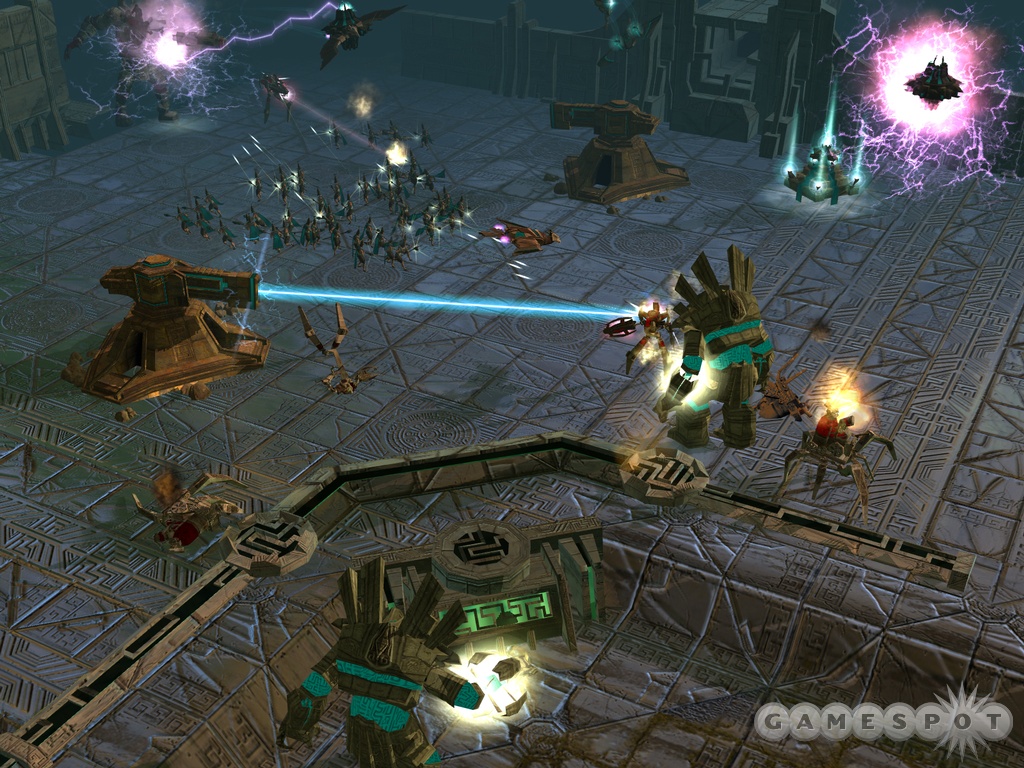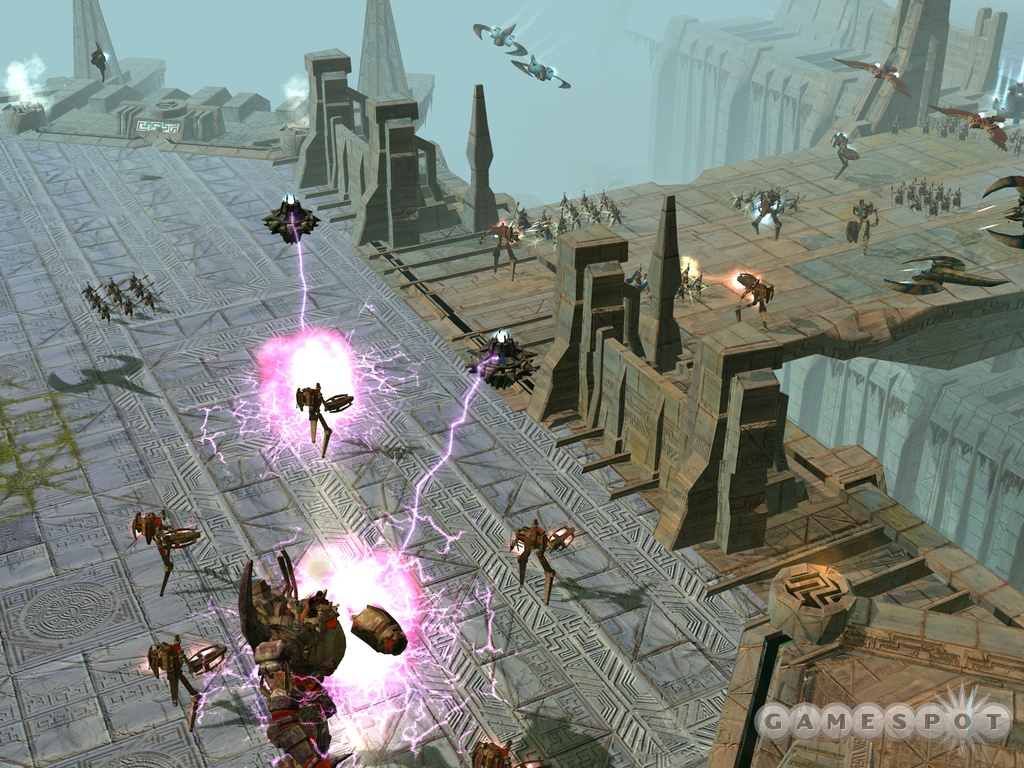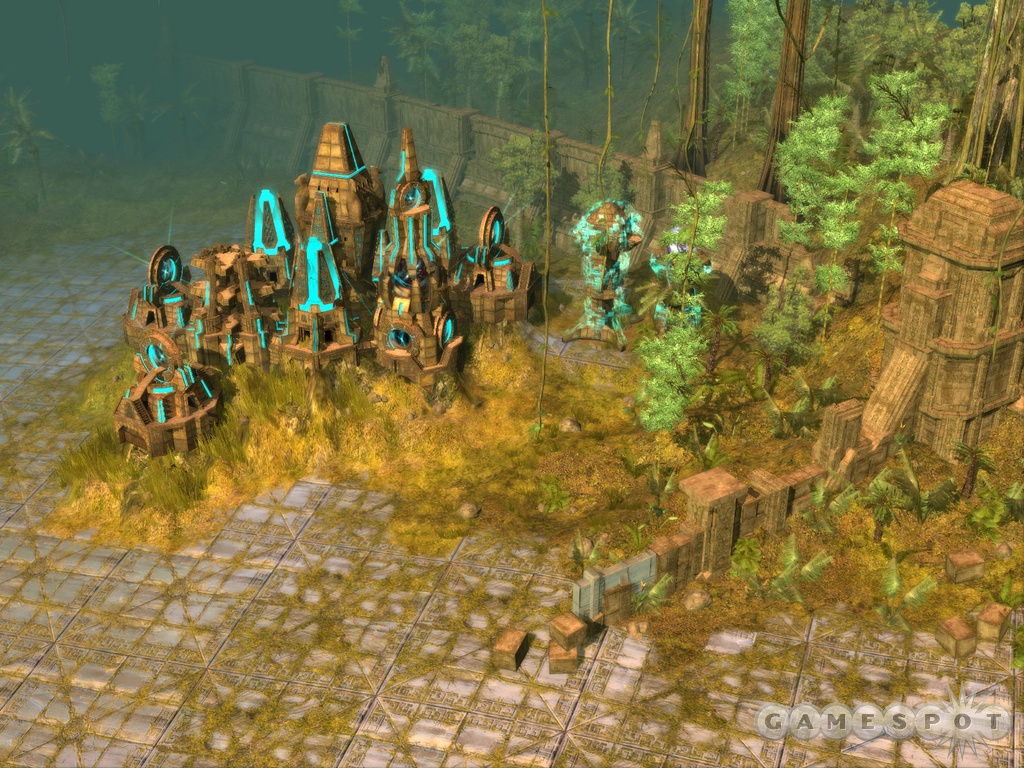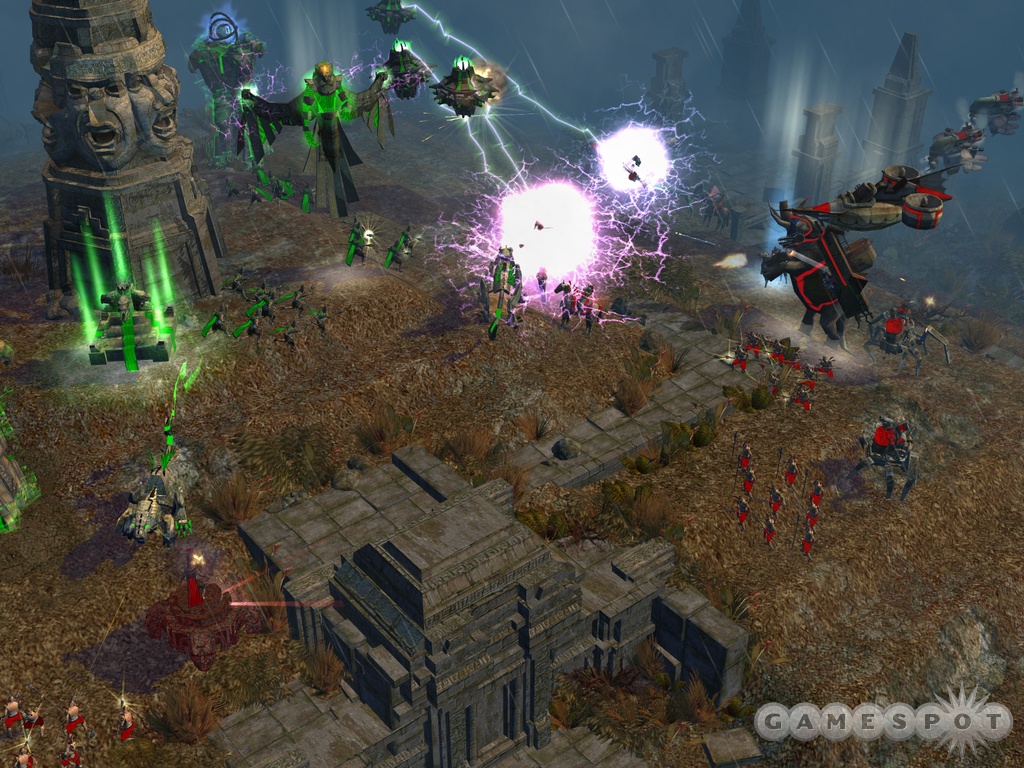Rise of Nations: Rise of Legends Q&A - More on the Cuotl, Neutral Nations, and Giant Leviathans
Big Huge Games' Paul Stephanouk tells us more about the mysterious Cuotl nation, and gives up more details regarding the game.
When Microsoft and Big Huge Games revealed the third and final nation in Rise of Nations: Rise of Legends earlier this year, it raised as many questions as it answered. The new faction is the Cuotl, a mysterious nation that is ruled by alien "gods" who crashed to the surface of the planet of Aio ages ago. While the Vinci and Alin nations are defined by technology or magic, the Cuotl have technology so advanced that it's almost magical. Obviously, this makes you wonder how the other nations will be able to deal with such advanced technology. To get the details, we checked in with Big Huge Games' Paul Stephanouk, the design lead for the single-player campaign.
GameSpot: The Cuotl are the major new revelation recently, so we're obviously curious about them. We know that they're the survivors of a wrecked alien spacecraft, but what else can you tell us about them? What kind of role do they play in the game's story?
Paul Stephanouk: First of all, I should clarify a point. The Cuotl people are indigenous to Aio. They are the ancestors of a civilization that existed prior to the arrival of the "gods." These Cuotl gods are from another planet and possess a number of advanced technologies. These visitors have subverted Cuotl religion to serve a number of purposes, not the least of which is maintaining control over an entire civilization of people.

But to answer your question, the Cuotl have two roles. First, the arrival of the "gods" long ago was a catalyst that influenced the modern form of more than one culture on Aio. Second, their near-term goals have set a chain of events in motion that send our main character, a young Vinci inventor, on a hero's journey across Aio.
GS: Now, the Vinci are influenced by Leonardo da Vinci's drawings and schematics, while the Alin are based on the Arabian Nights stories. Why did you go with a Mayan-style theme for the Cuotl?
PS: The premise of alien visitors influencing the development of human culture has been around for some time. Erich von Däniken's Chariots of the Gods, published in 1968, became a very popular and controversial book by speculating on how space travelers influenced the formation of several ancient civilizations. The Mayans are among his key examples.
On top of all this, the Mayans were just damn interesting. They had all sorts of amazing technology for their time period, such as a base-20 numbering system, their extremely accurate calendar, advanced architecture, and a civic system allowing population densities that rivaled modern cities. OK, so that last one didn't work out quite as well as the others, but you get my point.
Finally, talking about aliens-as-gods without acknowledging Stargate SG-1 would be like having a game with orcs and elves and overlooking Tolkien as an influence. Our premise and their premise are different, but both are von Däniken mythologies and Stargate is a wildly popular show, so how can it not be an influence? It's no secret that several members of the Big Huge Games team, included myself, are huge fans of both the movie and the TV series. I'd also like to give some credit to the late-1970's TV show Project U.F.O.. Does anybody else still remember it? I loved it and can still recite part of the opening.
GS: The entire point of the Cuotl is that they're aliens who have technology so advanced that it's almost magical. Given that's the case, what's to prevent them from simply wiping out the other factions? What sort of limits are put on them?

PS: At a macro level there are only a handful of them and they don't have full access to all of their technology at the moment. The ship did crash after all. It's not like Marshall, Will, and Holly ended up ruling the Land of the Lost just because they brought some modern trinkets to an ancient era.
Practically, the problem is power. Their technology requires a lot of it and they just don't have the means to use their technology in a totally unlimited fashion, at least not yet. In gameplay terms this means their units are individually more powerful but they have fewer and they are generally more expensive.
Leviathans
GS: Early on in the project, there were going to be four nations in Rise of Legends, but now that's trimmed down to three. In fact, supposedly one of the nations got folded into another. Care to tell us which faction got folded, and the reasons why? 
PS: As with every game, we had lots of ideas early on that didn't quite pan out for one reason or another. Our goal was never a specific number of races--it was to produce a game with a small number of races with very distinct gameplay and feel. There was an experimental race that wasn't working out very well for us early on. We decided that the game was better served by making sure that we had three great races to play. I'm really glad we made that choice. The game and the world are much improved for it.
GS: In addition to the three factions that you can play, there are all sorts of neutral nations and factions in the game that you'll interact with, and you can assimilate them peacefully or militarily or through domination, which appears to be a Cuotl-only ability. Can you give us the pros and cons for each method?
PS: When the Alin or Vinci wish to use non-military means to acquire a neutral site, they spend their trade resource (wealth). The Cuotl domination ability requires the use of the primary build resource (Timonium). That creates a very different gameplay dynamic. Domination also weakens/damages the target. It can be repaired but that takes some time and effort. Domination is fast and expensive. Trade can be much more subtle. I really enjoy how much these feel different in gameplay.
GS: How difficult is it to balance the three factions in the game? Rise of Nations had a couple dozen different nations to balance, so is Rise of Legends proving to be an easier game to balance, or a tougher one?
PS: In my opinion, balancing Rise of Legends has been much tougher. The races in Rise of Legends are very different from each other, while Rise of Nations' nations largely all use the same rules. My hat is off to our balance testers and design team that has worked so hard on this aspect of the game.
GS: We've had a chance to play the game and it's indeed an incredibly fast-paced experience. With that said, it seems logical that the side that can gain the control over the most cities in the game has a decisive advantage. How do you balance this in the game so that players can come back if they've got fewer cities?
PS: All cities aren't equal. Since cities are developed during play, not every city represents the same amount of investment. A player could potentially compensate for the loss of a city by upgrading an existing city. The neutral sites that a player can capture also represent a significant source of power. Depending on the situation, a player with less cities but more neutral sites than an opponent might even have an advantage.
GS: Multiplayer is a huge focus in Rise of Legends, but how dramatically does the dynamic change when you've got multiple people playing in a game, or playing in teams? Are there any special tools built in to help players coordinate with one another?
PS: I'd say the multiplayer game is quite a bit different than the single-player because each side has to be carefully balanced for a similar competitive goal. Most notably, there are quite a few units that are available in the single-player campaign that are not balanced for multiplayer. There are also buildings and locations that make great single-player scenarios but aren't really suitable for multiplayer gaming.
For multiplayer, we have the sort of tools that the modern real-time strategy gamer has come to expect: chat filters, ping tool, diplomacy/team settings, and so on. Multiplayer teams in Rise of Legends are easy and fun to play.
GS: Finally, any wild war stories that you'd care to share with us thus far? This is the kind of game that seems like it can have two or three huge changes in momentum in each battle.

PS: I really like the ability of the Vinci leviathan to burrow to a location. Having a giant leviathan show up in an unexpected location can confuse and demoralize an enemy. I usually wait and send my king leviathan deep into enemy territory when one of my cities comes under attack. My enemy is forced to decide between breaking off his attack to defend his territory or allowing me to tear up his economic buildings with my mechanical monster. I loves me some leviathan.
GS: Thank you.
Got a news tip or want to contact us directly? Email news@gamespot.com
Join the conversation